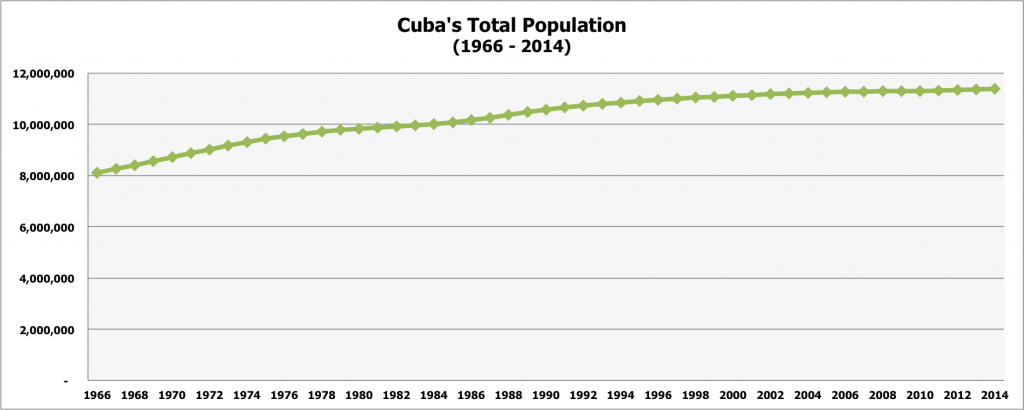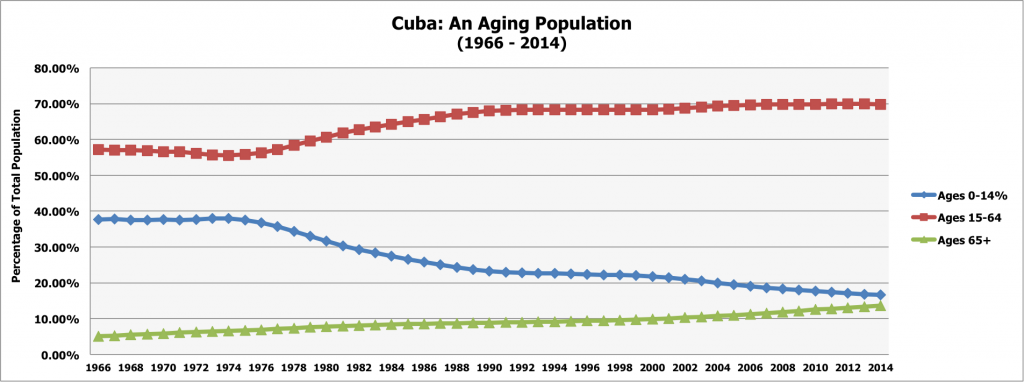Fast Facts (2015 Estimates):
Total Population: 11,031,433 (July 2015)
World Ranking: 80
Population Growth Rate: -0.15%
World Ranking: 210
Population Overview (1966-2015):
Over the past fifty years, Cuba has experienced minor population growth. Total population has grown from 8.10M in 1966 to 11.3M in 2015. However, social factors like emigration have stunted growth.

While a growing population can signal economic strength and indicate the presence of more consumers in the marketplace, it is important to also look at a population’s growth rate. From 1966 to 2014, Cuba’s population grew at an average annual rate of 0.7%. However, Cuba’s average annual growth rate has been declining for five decades. Based on the CIA World Factbook’s 2015 estimates, the current growth rate has dipped negative and is now -0.15%.
Birth, Death, & Migration Rates (2015):
Birth Rate: 9.9 births per 1,000
Total Fertility Rate: 1.47 children born per woman
Death Rate: 7.72 deaths per 1,000
Net Migration Rate: -3.66 migrants per 1,000
As potential investors, we are wary of the negative long-term effects that the figures above could have on the Cuban population. By itself, the rate of natural increase (the birth rate minus the death rate) yields a positive 2.18 people per 1,000. However, after deducting the net emigration rate, Cuba is left with -1.48 people per 1,000. Our primary concern is that Cuba’s population will begin to shrink if the net emigration rate does not improve.
Population by Age (2015):
Median Age: (Male 39.5 years / Female 41.3 year)
Life Expectancy: (Male 76.1 years / Female 80.8 years)
Age Structure:
15-24 years: 13.29%
24-54 years: 47.16%
55-64 years: 10.65%
65 years+: 12.95%
Since the early 1970s, the age breakdown of the Cuban population has drastically shifted. The 15-64 year old age group (the employed workforce) has significantly grown, and as of 2015, accounted for 71.04% of the total population. This figure represents both a large workforce from which businesses can hire talent and also a formidable consumer base.
Additionally, the 65 year old and above age group has experienced steady incremental growth. This growth could be fueled by higher standards of living within Cuba increasing life expectancy. It could also mean that only younger citizens are emigrating from the country, and thus, elderly citizens form a larger portion of the total population. As Cuba’s population continues to age, more elderly-focused businesses and services (e.g., skilled nursing) will be needed. New entrepreneurial businesses, such as retail delivery services, could spring up to meet these needs. Similarly, existing industries like healthcare could experience increased growth.
However, not all age groups are experiencing positive growth. The 0-14 year old portion of Cuba’s population has been steadily declining since the mid-1970s. If this trend continues, Cuba’s population will face two major socioeconomic issues. First, there will be a shortage of employees in the workforce. Specifically, there will be more elderly people retiring than young people available to replace them. Second, a smaller workforce equates to less people supporting each retiree. We will delve deeper into this when we examine dependency ratios in the Social Security segment of our analysis.
Rural vs. Urban Population (1966-2015)
As a population, Cuba has become increasingly urbanized. Having a predominately urban, and less rural, population can facilitate knowledge transfer and economic development. We view this shift has being a positive indicator of potential economic growth.
Population Density (2015):
Population Density = Total Population ÷ Size of Land Area
Cuba = 11,031,433 people ÷ 109,820 people per km²
Cuba = 100.45 people per km² or 260.16 people per mi²
In 2015, Cuba’s population density was 100.45 people per km². This means that on average there are approximately 100 people inhabiting each km² of land. To a business owner, this means that every km² has 100 potential consumers who will need goods (e.g., groceries and clothing) and permitted private services (e.g. restaurants). To an investor, this provides a general idea of how many businesses can be profitably sustained by each km².
To create a baseline for comparison, we looked at world population density rankings for 2014. We found that Cuba (107 people per km²) ranked between the United Arab Emirates (109 people per km²) and Albania (106 people per km²). Next, we looked at the CIA World Factbook’s most recent ranking of GDP per capita (purchasing power parity) of the UAE and Albania. Our goal was to determine whether Cuba’s population density is an accurate indicator of the country’s wealth. Based on our comparison below, population density does not appear to be a strong factor that influences a nation’s wealth.
Literacy Rates (2015):
Cuba’s population has an extremely high literacy rate of 99.8%. This indicates that virtually all adult members of the population (as defined as being 15 years+) have the fundamental skill that is required to participate in a developed economy. To a potential investor, this signals the presence of a capable workforce that is able to participate in value-adding economic activities (e.g., small business ownership) and in potentially high-growth industries (e.g., tourism/hospitality and retail services).
Sources:
The CIA World Factbook
The World Bank – World Development Indicators




